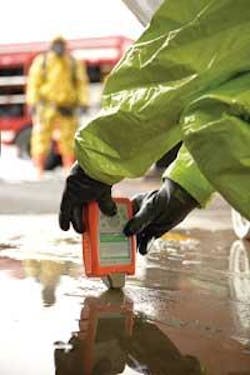
A trip to the “Big Easy” may evoke images of slower, more genteel times, but Pittcon 2008, held March 1-7 at the massive Ernest N. Morial Convention Center (New Orleans, LA), did its best to showcase the latest advances in size and speed of advanced microscopy and spectroscopy systems. More than 1100 companies from 85 countries displayed their wares in the 1.1 million square feet exhibit hall; total attendance was about 19,500.
The conference featured more than 2000 papers and posters covering everything from bioanalytical chemistry and biomedicine to neurochemistry, polymer science, informatics, nanotechnology, applied molecular spectroscopy, environmental chemistry, and forensic analysis. Hot topics included Fourier-transform infrared (FTIR) imaging and Raman spectroscopy for a broad spectrum of applications, plus a special symposium on using analytical techniques (optical and otherwise) to assess biodiesel quality.
Things got off to a great start with the plenary presentation given by Dr. Leroy Hood, president of the Institute for Systems Biology (Seattle, WA) and an award-winning pioneer in the field of DNA sequencing. Over the last 40 years Hood’s research has focused on fundamental biology and on bringing engineering to biology. He helped develop DNA and protein sequencers and synthesizers and the ink-jet oligonucleotide synthesizer for making DNA arrays—instruments that provided the technological foundation for modern molecular biology and genomics and for which he was honored with the Kyoto Prize for Advanced Technology in 2002. He has since applied these technologies to a number of fields including immunology, neurobiology, cancer biology, and molecular evolution.
Hood’s talk focused on the increasing role of spectroscopy, microscopy, and related technologies in systems biology and the emerging field of “systems medicine.” He believes that systems medicine, together with advances in DNA sequencing and blood-protein measurements at the nano scale and new computational and mathematical tools, will transform medical care and the entire health-care industry over the next 5 to 20 years, taking it from a reactive state to a model that is predictive, personalized, preventative, and participatory.
“Biology is one of the dominant sciences in the 21st century. It will transform many aspects of society in fundamental ways, and systems biology in particular will impact other sciences such as engineering,” he said. “If you understand networks you can re-engineer them, and this will have an important impact on the treatment of disease in the future.”
Hood emphasized the impact technology will have on medicine in the next decade, particularly in genomics. He believes that 10 years from now we will all have had our genomes mapped and that, in fact, there will be home-based handheld devices for a variety of blood-based disease diagnostics as a result.
“With this information we can devise and design drugs that not only treat perturbed networks but prevent those networks from becoming perturbed in the first place,” he said. “From a technology point of view, the digitization of this information is going to have a tremendous impact on medicine.”
Smaller, faster, even cheaper
Down on the show floor, there were a number of new products that are poised to help enable Hood’s vision by making “high-end” spectroscopy and microscopy easier to use and more cost effective—and thus more appealing to a broader user base. DeltaNu (Laramie, WY), for example, introduced what it claims is the world’s smallest Raman spectrometer, the ReporteR. The palm-size, 11 oz system is designed for rapid identification of illicit drugs, explosives, plastics, and industrial chemicals.
Vying for the title of smallest spectrometer at Pittcon was the Exoscan FTIR spectrophotometer from A2 Technologies (Danbury, CT). Designed to move spectroscopy out of the laboratory and into the field, the Exoscan weighs less than 7 lb and is designed for nondestructive on-site surface and bulk analysis applications such as analyzing composite aircraft wings. Controlled and operated via a PDA device, the Exoscan features interchangeable internal reflectance and external reflectance sampling interfaces and is intended for sampling a variety of materials including solids, pastes, gels, and liquids.
Ahura Scientific (Wilmington, MA) is targeting the field-based chemical-identification market with its TruDefender FT product, a 3 lb palm-size FTIR system introduced at Pittcon that is optimized for hazmat (hazardous materials) and military applications (see figure). The TruDefender FT was recognized by Strategic Directions International (www.strategic-directions.com) as one of the top three innovative new products at Pittcon 2008. The others were a DNA (deoxyribonucleic acid) analysis system from Shimadzu and a spectrometer for the biopolymer and biotechnology markets from Horiba Jobin Yvon.
Thermo Fisher Scientific (Waltham, MA) also made a splash with two new compact, modular lab-based products: the DXR Raman microscope and the DXR SmartRaman spectrometer. The DXR Raman microscope is designed to help nonspecialist users achieve rapid sampling and analysis of particles, down to 1 µm spatial resolution, while the DXR SmartRaman spectrometer is intended specifically for quality-control lab-based applications.
About the Author
Kathy Kincade
Contributing Editor
Kathy Kincade is the founding editor of BioOptics World and a veteran reporter on optical technologies for biomedicine. She also served as the editor-in-chief of DrBicuspid.com, a web portal for dental professionals.